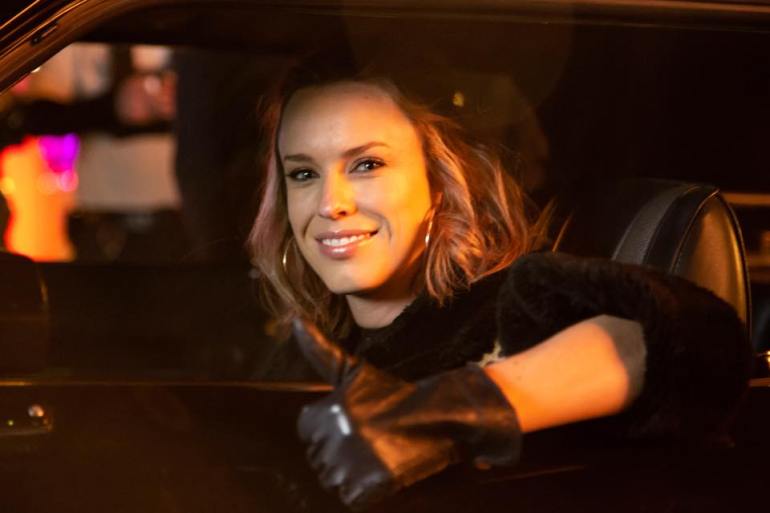Jessica McNamee stars in Heath Davis’ ‘Locusts’.
Far fewer directors in Australia get the chance to make their second feature, or more, than the global average.
According to a new, ground-breaking study of worldwide trends by UK analyst Stephen Follows, while 63.5 per cent of directors have one feature film credit, 36.5 per cent made a second feature.
Just 8.6 per cent directed more than five and only 0.1 per cent have more than 20 feature credits.
By comparison, Screen Australia’s most recent research found 62 per cent of directors had one credit in the five years to June 2017 and 44 of the 144 surveyed – 19 per cent – had made a second feature.
Broken down by gender, that equated to 42 male directors (22 per cent) and just two women (6 per cent). Some 8 per cent had three credits, 4 per cent had four and 7 per cent had 5-plus.

To be fair, Screen Australia’s research is a relatively small snapshot compared with Fellows’ study, which tracked all feature films made worldwide in the past 70 years – nearly 289,000 titles – drawing on such databases as IMDb, The Numbers, Wikipedia and Box Office Mojo.
The disparity between the global and Oz percentages of second-timers does not surprise Australian directors. “We have known for a while that making a second feature is really difficult,” Australian Directors Guild CEO Kingston Anderson tells IF.
Anderson expects there will be little change in the next set of Screen Australia research due in May, except for the continuing rise of Indigenous feature directors including Wayne Blair, Warwick Thornton, Ivan Sen and Rachel Perkins.
As he observes, many male and female directors are happily working here and abroad on dramas for streaming services and international broadcasters. The US or UK-based cohort includes Jessica Hobbs, Daina Reid, Kate Woods and Jen Perrott.
Anderson adds: “There is a view (among funding agencies) that new people should be supported rather than those who have experience. We are not developing long-term career prospects.”
“I’m not surprised,” says Heath Davis, who found the only way to make his three films- Broke, Book Week and the upcoming Locusts – was to write, direct and produce or co-produce.
“The film industry is a closed shop; at least it always has been for me,” adds Davis, the founder of the indie filmmakers co-operative Cinegar Bar. “Like a lot of things in life, talent is second to relationships. Two films isn’t even enough now. Directors need to be producers now in the indie landscape. And we all need to help one another. “
Writer-director James Di Martino, who made his feature debut on horror movie The Faceless Man, says: “The fact that many directors never see money from their first feature is one of the reasons I see that people leave the industry or find it hard to raise funds.
“Many first time directors use a combination of crowdfunding and their own money to get these features off the ground. Also there is a desire to shoot the second film at a higher budget and improve on the first.”

Ben C Lucas, who co-directed Fighting Season after helming the features Wasted on the Young and OtherLife, contends: “One film is just one film but we elevate the importance of that credit disproportionately, hence the fall-off. Those who jump straight to a second feature (be it a success or failure) are the exception not the rule.
“Quite often a director will do their first feature then enter a slump during which time they’re considered too big for smaller jobs, but not big enough to have a financially viable career. They’re trapped with the only options being to either a) stay on the development treadmill until something sticks; b) switch to another part of the business like TV; or c) quit.
“All the living masters working today have made a lot of bad films, that’s why they’re masters. But now the industry is so competitive it’s actually harder to sharpen the skills because one’s worth is hung off a single credit.”
Angela How, who is in post on her debut feature, thriller Rock Sugar, takes a positive view, observing: “I have director friends who go on to make more than one film, both male and female. It just takes a lot of drive and determination, as is the case for making any film.
“I don’t look at statistics much because they tend to be rather depressing. It’s a bit like getting your fortune read – kinda counter-productive, and not helpful.”
Says Matthew Holmes, writer/director/producer of The Legend of Ben Hall: “The odds are against directors. Always have been. It’s a gruelling game.”
Follows’ study also found there was a steady decline over the years in the percentage of repeat directors. He says: “This could be read as a negative trend for directors (i.e. it’s becoming ever-harder to make a second movie) or a positive one, i.e., it reflects how the barriers to entry in the film industry are falling, meaning that directing is open to a much larger constituency of people than in the past.
“It’s worth noting that ‘not directing a second film’ is not the same as ‘failing to be a director.’ Some one-time film directors will go on to direct other media, such as TV shows, adverts and music videos. Others may have directed as a way to launch their primary careers, such as acting or writing.”



